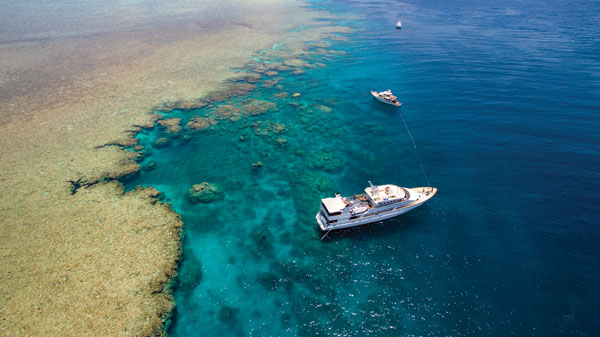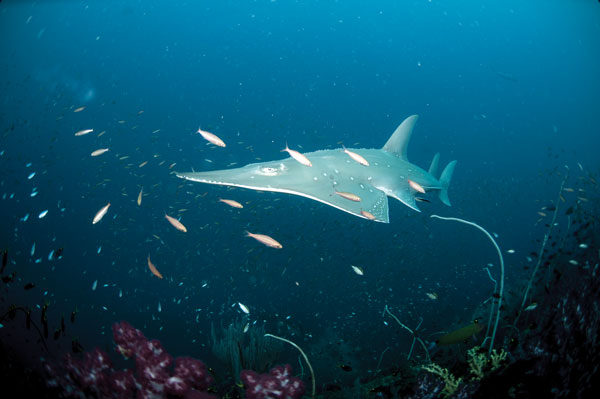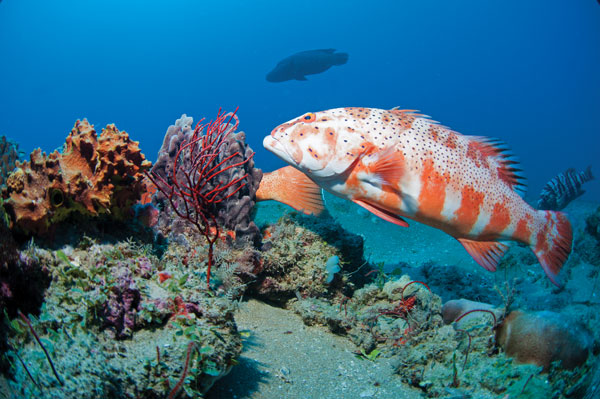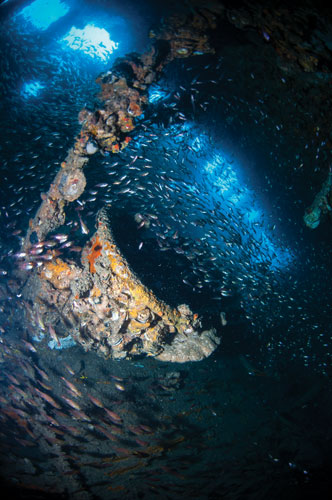Diving Queensland, Australia
Australia doesn’t mess around when it comes to species, enourmous reefs, and impressive wrecks
Words by Eric Vohr

The Great Barrier Reef is so enormous it can be seen from outer space. At a staggering 1430 miles (2300km) in length, it is one of the best known and most complex natural ecosystems in the world. It supports a unique range of ecological communities, habitats, and species across a range of depths, making it – and the waters of the aptly named Coral Sea off the coast of Queensland, Australia – a diver’s dream destination.
While rising sea temperatures and overuse has affected some of the reefs closer to the mainland of Australia, if you get out to the far outer reefs, you can still find the abundance of pristine and healthy corals and creatures for which this region is known.
And that’s exactly what we did when my photographer dive buddy and I joined a three-night/eleven-dive adventure on one of the most comfortable and best-equipped liveaboard dive boats in the region. This trip, the 3 Day Cod Hole expedition offered on liveaboard Spirit of Freedom, took us 150 miles (240km) north from Cairns, Australia, along the pristine Ribbon Reefs to the famed Cod Hole.

Appetizer
Our first stop on the outer reef was Saxon’s Reef, where we did a pleasant twilight dive. I only travel with my fins and mask and a few other lightweight items, so the first thing I notice with any dive company is the quality of the gear and the competency of the staff. Spirit of Freedom scored very high points in both areas. I especially liked their “fin service”, where they help guests get into their fins on the dive deck just before entering the water. It’s not a big deal, but it’s the little things that make the experience rise to the next level.
Once we entered the water the magic really happened. Even though we had yet to reach the famed Ribbon Reefs, the coral and marine life at Saxon’s Reef more than justified the lengthy travel time it took to get to Australia and the Great Barrier Reef.
I was blown away by the huge density of small reef fish, the great visibility, and the amazing coral formations. I came face to face with a massive Maori wrasse and also encountered octopuses, trigger fish, giant moray eels, and blue-spotted stingrays. The staff told me that this dive spot was just a teaser and I would be even more amazed when we reached the Ribbon Reefs, so the exciting only mounted as we steamed through the night.

Main course
The next morning, we started with an early morning dive. This first full day would introduce us to a rigorous but enjoyable four-dive-a-day schedule we’d follow over our entire trip. We spent two days at the Ribbon Reefs, diving Steve’s Bommie, Rouge, Towers of Tomoko, Challenger Bay, Google Gardens, Cod Hole, Snake Pit, and Dynamite Pass. It was such a smorgasbord of diving and dive encounters, it is difficult to say which site I liked best.
Steve’s Bommie is a 100 foot (30m) pinnacle and one of the most popular dive sites in the region. You start deep and slowly drift upwards, circling the bommie, and experiencing a constantly changing array of marine life. On our dive, this included reef sharks, tiny leaf scorpion fish, amazingly coloured nudibranchs, and bat fish who curiously circled us during our safety stop.
Rouge, Towers of Tomoko, and Challenger Bay are all around 60 feet (18m) deep, so the colours are more vibrant. Here we were treated to pulsating xenia corals, flatworms the likes of which I’ve never encountered before, walking feather stars in all colours, massive loggerhead turtles, and a magical peacock mantis shrimp.

Signature dish
One of the highlights of the Ribbon Reefs was the last of our dives at the Cod Hole, which is home to a large school of enormous potato cod. These friendly fish are as big as humans and very inquisitive. The first part of the dive we kneeled in a circle on the sand as they swam around us. Later, we got a chance to swim around them as they hovered around our dive group, apparently as curious about us as we were of them.
The final two dives of our trip were Snake Pit and Dynamite Pass. The former is an array of eight bommies arranged in two lines. There’s supposed to be a manta feeding station at the northern most bommie, though we did not see any of these amazing creatures. Regardless, it was a fantastic dive that provided poisonous olive sea snakes, cuttlefish, blue-spotted and black-blotched rays, colourful whips, fans, and other hard and soft corals.
At Dynamite Pass we did a tactical, dinghy-based water entry and then enjoyed a drift dive along Cormorant Reef, which was on par with all of the excellent dives we did on Ribbon Reef. We searched the deep blue for big sea creatures and saw a few large Maori wraths, but no big sharks or dolphins. We were told that in June and July these waters are rife with migrating minke whales.
Our trip ended with a land excursion on stunning Lizard Island and an amazing low-level flight along the coast back to Cairns, from which we could see (quite literally) why Queensland’s slogan is “where the rainforest meets the reef”.
The small plane brought in new divers who had booked the next dive excursion, which included a trip to Osprey Reef. This former volcanic atoll lies more than 125 miles (200km) off the coast and is known for its spectacular 3,000-plus foot (1000+m) walls, massive soft corals, amazing shark action, and exceptional visibility. This, together with Bougainville Reef, which has amazing caves and swim-throughs, will be my liveaboard trip-of-choice on my next visit here.
But the Great Barrier Reef is not the only place in Queensland that has epic diving. Another dive site for which it’s more than worth getting wet is the famed S.S. Yongala wreck – a 350 foot (107m)-long passenger and freight ship that went down in a cyclone in 1911 in 88 feet (27m) of water. It remained undiscovered for many decades and is now a thriving artificial reef, with unique inhabitants like guitar sharks and giant marble rays. Some divers claim it has ten times the marine wildlife that you’d find at the Great Barrier Reef. I can attest I literally had to push schools of fish out of my way to see the wreck.
There are few places with as much great diving as you’ll find in Queensland. But diving isn’t the only dish available on the menu here. Consider factoring in some time for land exploring, as this is one of the most beautiful, lush, and wildly pristine areas in Australia. With dense jungles, crystal mountain streams, waterfalls, exotic animals, and hundreds of miles of some of the most beautiful beaches in the world, the diving is just the beginning.
Good to Know:
Getting there: Fly into Cairns airport (usually via a stop in Sydney, Brisbane, or Melbourne). Most foreign visitors will need a passport valid for at least six months and an approved ETA (Electronic Travel Authority) before arriving in Australia.
When to go: Anytime is a good time to dive in Queensland. It is a hot and humid, year-round destination with temperatures averaging 83°F (28°C) in January and 71°F (22°C) in July. In the rainy season (November to April) you’ll get near-daily rainfall but also warmer waters. The dry season offers more comfortable daytime temperatures and conditions, as well as opportunities to dive with minke whales. Australian spring (October till December) is the best season to dive the outer walls of the reefs in the Far North, offering a great chance encounters with sharks, manta rays, and massive schools of pelagics.
Dive with: Spirit of Freedom: www.spiritoffreedom.com.au Divers Den: www.diversden.com.au Yongala Dive: www.yongaladive.com.au
Dive Details: Most dives require just a basic dive certification. However, the Special Expeditions by Spirit of Freedom cater to more experienced divers who can handle strong current and different methods of entry and exit.
Chamber location: In Townsville and Brisbane
Water temp: The average year-round warm water temperatures of 72°F (22°C) in July/August and 84°F (29°C) in January







